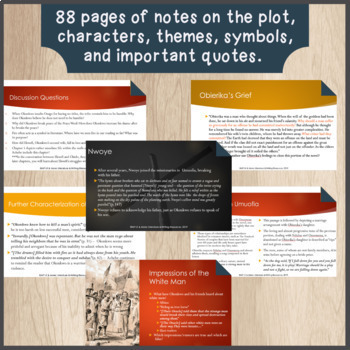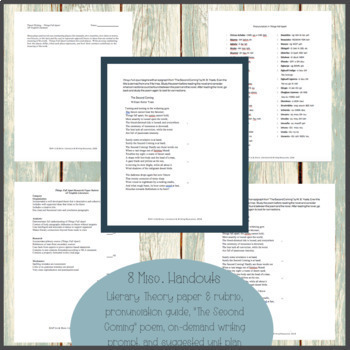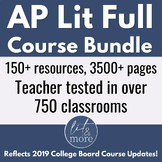Things Fall Apart Unit for AP Lit | Editable Notes & Engaging Student Activities
- Zip
- Google Apps™

What educators are saying
Products in this Bundle (4)
Bonus
Also included in
- This AP English Literature Full Course Year Long bundle provides extensive materials for teaching AP Lit for an entire year. Perfect for both first year teachers and AP Literature teachers looking for a refresher. Teaching AP English Literature and Composition can seem to be an overwhelming endeavorPrice $298.00Original Price $601.25Save $303.25
Description
This new and improved bundle contains everything you will need to teach Chinua Achebe's novel, Things Fall Apart in AP English Literature and other advanced literature courses. The notes, quizzes, test, and study guide are now also available in interactive Google versions for online use. The bundle contains the following:
- 10 PowerPoint presentations of introductory and chapter guided reading notes
- 1 answer key for discussion questions, aligned with Guided Reading Notes
- 1 poem study slideshow guiding students through W. B. Yeats' "The Second Coming"
- 2 novel quizzes + keys
- 1 timed writing prompt & holistic rubric
- 1 unit test + answer key
- 1 Literary Criticism paper and rubric
- Pronunciation guide for characters and places
- Recommended unit plan and written reflection prompts for homework
- 9 AP® Lit skill-based minilessons, aligned with chapter notes, including:
- Tone (Chapters 1-3)
- African Proverbs (Chapters 3-4)
- Prose Analysis (Chapter 7)
- Syntax (Chapters 9-10)
- Folk Tale (Chapter 11)
- Connotation & Denotation (Chapters 14-16)
- Rhetorical Analysis (Chapters 17-19)
- Poem Study - Bassey Ipki's "Homeward" (Chapters 20-22)
- Point of View On-Demand Paragraph (Chapter 25)
This unit is aligned with standards from the AP® Lit CED for Long Fiction Unit III. The following skills are instructed and assessed:
- CHR 1.B – Explain the function of a character remaining unchanged
- CHR 1.E – Explain how a character’s own choices, actions, and speech reveal complexities in that character, and explain the function of those complexities
- STR 3.E – Explain the function of a significant event or related set of significant events in a plot.
- STR 3.F – Explain the function of a conflict in a text.
- NAR 4.C – Identify and describe details, diction, or syntax in a text that reveal a narrator’s or speaker’s perspective.
- LAN 7.B – Develop a thesis statement that conveys a defensible claim about an interpretation of literature and that may establish a line of reasoning.
- LAN 7.C – Develop commentary that establishes and explains relationships among textual evidence, the line of reasoning, and the thesis.
- LAN 7.D – Select and use relevant and sufficient evidence to both develop and support a line of reasoning.
The slideshow notes, quizzes, and test are in PowerPoint and Word form so you can make edits. Most other resources are in PDF form. The files are clear and colorful, as well as thought-provoking and ready to use.
This resource is included in my AP®Lit Full Course Bundle!
AP® is a trademark registered by the College Board, which is not affiliated with, and does not endorse, this website.





